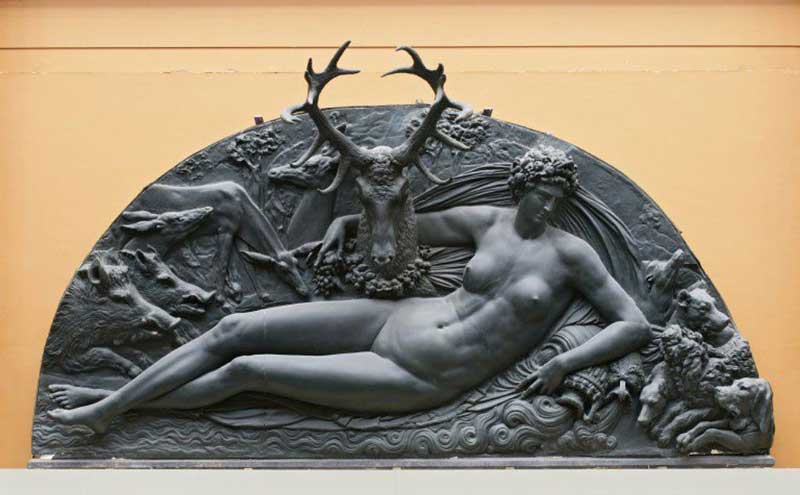
The composition of the sculpture Diane d'Anet or Diana with a Stag, depicting a semi-reclining Diana, the Roman goddess of the hunt, accompanied by her two dogs, Phrocyon and Cyrius, with her one arm around the neck of a majestic stag, is considered as a masterpiece of harmony. The reclining figure of the naked goddess and the majestic presence of the stag with tall antlers, which draw the group to the left side, are rhythmically balanced by the sculptor with a bow in the raised left arm of the goddess. The head of Diana and the royal stag are turned in the same direction, to ensure the coherence of the scene. With her elongated Mannerist figure, the softness of her body, the tiny high breasts, beautiful eyes and remarkably refined hairstyle, Diana epitomized the regal elegance of School of Fontainebleau art: It seems that the sensuality of Diana stems from the contrast between the nakedness of the body and the elaborateness of the hairstyle.

During the mid-16th Century, the sculpture named Diana with a Stag surmounted the monumental Fountain of Diana or La Fontaine de Diane, built by Philibert de L'Orme and installed in the courtyard of the Château of Anet. It is said that the sculpture was created after Diane de Poitiers, the mistress of Henry II. However, it is argued by many that, it was not the true portrait of Diane de Poitiers, the lady who wielded much influence and power at the French court as King Henry's chief mistress. It was rather one of the many images of moon goddesses that closely related to the painting ‘Diana the Huntress’ by a School of Fontainebleau and a mythical representation of Diane de Poitiers.
However, Diana with a Stag is definitely evocative of the ‘Nymph of Fontainebleau’, a high relief sculpted by the Italian artist Benvenuto Cellini, commissioned by Francis I, which was later installed above the main entrance to the Château of Anet in the mid-16th century, by Philibert de L'Orme, transforming the nymph into Diana, the goddess.

Nevertheless, the fountain was moved to the nymphaeum in the 18th century, before being confiscated during the Revolution and transferred to the Musée des Monuments Français in 1798. Subsequently, it was restored by French sculptor Pierre-Nicolas Beauvallet in 1799-1800 and placed in the museum's Elysée Garden. After that it was claimed by the duchess of Orléans, owner of the Château of Anet, where it originally belonged, but finally allocated to the Louvre by ministerial decree in 1819.
Diana with a Stag was traditionally attributed to the French Renaissance sculptor and architect Jean Goujon. However, the name of its creator is actually unknown. It has been attributed, in turn, to Benvenuto Cellini, Germain Pilon, Pierre Bontemps, and Ponce Jacquiot. But, it is hard to find the truth, as the statue was heavily restored in the 18th century and then again in 1799-1800.
